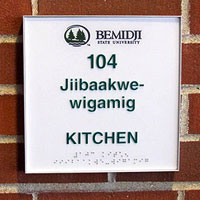17 April 2011
Native Signs

Signs in Bemidji, Minnesota used to read “No Indians Allowed.” Now local businesses increasingly announce their facilities in both English and Ojibwe.
Racism and social exclusion have a long history in the town, but as Tanya Lee writes, a 2005 proposal to voluntarily incorporate Ojibwe words on public signage is having a growing impact:
The idea came in part from Hawaii, where [Michael] Meuers had lived for a year in the 1960s. On the islands, he recalled, native language and culture are a part of everyday life for everyone, as the familiarity with words such as mahalo, luau, aloha, lei and hula prove. On restroom doors, the words men and women are displayed in English and in Hawaiian.
In 2005, a student at Red Lake High School, a school for Red Lake students run by the state of Minnesota, opened fire on the campus with a shotgun and a semiautomatic pistol, killing seven.
“The next day, I was talking to the city manager and noticed a Red Lake flag on a shelf,” Meuers said. “I was working for the tribe at that point and I suggested the city fly the flag. The Red Lake flag flew at half-staff outside City Hall for a week. I never heard so many positive comments about Bemidji. It was the people of the city saying, ‘Bemidji is crying for the Red Lake babies too.’ ”
This prompted Meuers to take his simple idea about the bathroom signs to Shared Visions, a community organization dedicated to addressing the issues of racial disparity and bias. Rachelle Houle served with Meuers on the Cultural Understanding and Respect Committee, and together they set the goal of placing restroom signs in both Ojibwe and English in 20 businesses within a year. Meuers volunteered to pay for the signs.…
“Michael and I both feel a change happening here,” Houle said. “For so long, the Ojibwe culture and people have not been respected here. This is a way of saying, ‘You are valuable.’ It’s a way of showing respect and making people welcome in Bemidji.”…
[Dr. Anton Treuer, professor of Ojibwe at Bemidji State University] says the university has received many calls and e-mails about how to replicate the [universty’s signage] program, and he believes it can serve as a template for other tribes. “We were taking our signs around town when we started,” Meuers said, “and now people are coming to us, not only from the U.S. but also from Canada.”
![]() 17 April 2011, 2:48 PM | LINK | Filed in
nationalism, public space, racism, wayfinding
17 April 2011, 2:48 PM | LINK | Filed in
nationalism, public space, racism, wayfinding
Read more items related by tag:

